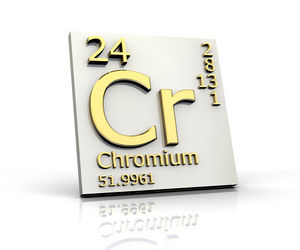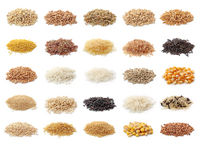Chromium
| See Also | Minerals |
|---|
Chromium is an essential mineral probably best known for its effects on blood sugar control. In 1957, Walter Mertz and Kenneth Schwartz were able to isolate what they called, glucose tolerance factor, form pork kidney. Later, it was discovered that chromium is the active component in glucose tolerance factor. In can be said then, that chromium is critical for proper insulin action and glucose control [1].
Contents
Food Sources
The following foods have the highest concentration of chromium. For a more expansive list on food sources of specific nutrients visit Health Canada's Dietary Reference Intakes for Elements or USDA's National Nutrient Database
- Best Sources of chromium is brewer's yeast, but many people avoid this food as it can cause bloating. Other food sources of chromium include:[2]
- grains: whole grain products, wheat germ
- protein sources: beef, liver, eggs, chicken, oysters
- vegetables: green peppers, spinach
- fruit: apples, bananas
- dairy: not typically found in dairy products other than butter
- Other sources of chromium include: Black pepper and molasses.
Uses
The following are the primary uses of chromium. [1] [3]
- Impaired Glucose Tolerance and Diabetes: Chromium has the ability to improve blood sugar control. Chromium deficiency is common in those with non-insulin-dependent diabetes mellitus (type II diabetes). Studies have shown that supplementation with chromium decreases fasting glucose levels, improves glucose tolerance, lowers insulin levels, and decreases total cholesterol and triglyceride levels while increasing HDL (good) cholesterol levels. Chromium has been shown to decrease symptoms of hypoglycemia, improve glucose tolerance test results, and also increases the number of insulin receptors on red blood cells.
- Elevated blood cholesterol and Triglyceride Levels: Chromium also lowers cholesterol and triglycerides in non-diabetics. Results are not remarkable unless the individual is extremely deficient in chromium. Even the small changes, however, can be clinically significant in terms of lowering ones risk of a heart attack.
- Promotion of Weight Loss: It has to ability to regulate glucose levels via its effect on insulin, chromium also has the ability to promote weight loss. Supplementation of chromium both increases fat loss and increase lean muscle mass.
- Acne: Some dermatologist state that insulin is an effective treatment for acne, which suggests that there may be disturbances in glucose uptake and insulin sensitivity in the skin causing acne in some individuals. High chromium yeast supplementation has shown good results in patients with acne.
- Depression: Hypoglycemia and unstable blood sugar can aggravate depression and anxiety, thus treating these conditions may help to alleviate these conditions. Concomitant chromium and antidepressant drug therapy has been shown to increase the effectiveness of drug treatment.
Deficiency Symptoms
- glucose intolerance (elevated blood sugar and insulin levels)
Excess Symptoms
Excess symptoms and toxicity are not generally seen at doses normally used. The only side effects noted (at doses of 50mcg daily) are [1]
- increased dream activity
- greater vividness and colour in dreams
- diminished sleep requirements
Long-term use of chromium picolinate, particularly at doses above 400mcg/day are best undertaken under supervision by a trained health professional.[4]
The risk of chromium toxicity could be greater in individuals with pre-existing liver or kidney disease.[4]
Assessment Procedure
Best Specimens to Collect: [5]
- RBC Chromium - a low level indicates a deficiency
- Hair Mineral Analysis - a low level indicates a deficiency
Prescribing Considerations
- Chromium is available as chromium picolinate, chromium polynicotinate, chromium chloride, and chromium-enriched yeast. It is not clear which form offers the most benefit [1]
- The recommended dosages varies based on age and health status. To determine what your specific requirements are talk to your naturopathic doctor or other trained medical professional.
There is no official RDA for chromium. The following are considered safe and adequate ranges.
- Infants: 10-40mcg (under 6 months); 20-60mcg (6-12 months)
- Child: 20-80mcg (1-3 years); 30-120mcg (4-6 years)
- Child (7+ years) - Adult: 50-200mcg
Safety
- Children: The maximum safe dose for chromium for infants and children has not been established.
- Adults: generally regarded as safe
- Seniors: generaaly regarded as safe
- Pregnancy and Breastfeeding: The maximum safe dose for pregnant or breastfeeding women has not been established. It is advised to avoid doses of chromium greater than 50mcg/day. Chromium appears to be safe for use when treating gestational diabetes. Supplementation during breastfeeding does not appear to increase amounts found in breast milk.
- Contraindications: in individuals who are hypersensitive to any component of the chromium formulation; those with sensitivities to yeast should avoid yeast-derived or yeast-containing forms of chromium; chromium picolinate might be contraindicated for individuals with depression, bipolar disease or schizophrenia.
- Precautions: professional supervision is advised for individuals with hypoglycemia who are introducing chromium; individuals being treated for hyperglycemia or type II diabetes should only introduce or adjust doses of chromium with professional supervision.
Drug Interactions
- Drug Interactions include:[4]
- Supportive or Beneficial:
- Beta-1-Adrenoceptor Antagonists - Improvements in lipid status with concomitant use may occur, particularly elevation in HDL cholesterol.
- Insulin, Glyburide, Metformin, and related oral Hypoglycemic agents - Co-administration of chromium with exogenous insulin or oral hypoglycemic medications may provide therapeutic benefit by enhancing insulin activity and glucose control. However, inappropriate combining could induce hypoglycemic reaction.
- Sertraline and Related Selective Serotonin Reuptake Inhibitor (SSRI) Antidepressants - Disparate and indirect evidence indicates that chromium may benefit individuals with depression through effects on glucose control and potentiation of insulin. Chromium picolinate appears to increase peripheral availability of tryptophan for brain serotonin synthesis and alters sensitivity of central serotonin receptors.
- Addresses Drug-Induced Deficiency:
- Corticosteroids, oral - Increased chromium excretion is associated with corticosteroid therapy and may play a role in steroid-induced diabetes. Co-administration can prevent drug-induced depletion and may reverse steroid-induced diabetes.
Nutrient Interactions
- Nutrient Interactions include [4]
- Biotin - Chromium picolinate and biotin appear to work together to enhance glucose uptake in skeletal muscle cells and improve glucose disposal.
- Calcium - Concomitant intake of calcium carbonate and chromium can interfere with the absorption of both agents and thus reduce the activity of chromium intake.
- Carbohydrates - Excessive intake of sugars and other simple carbohydrates may increase the amount of chromium excreted through the urine.
- Iron - Chromium and iron compete for binding on transferrin, the iron transport protein. Thus, excessive levels of either mineral can interfere with transport of the other.
- Vanadium - and chromium appear to have synergistic action. Human trials are needed and until then, professional supervision is appropriate for individuals with diabetes who choose to undertake such therapies.
- Vitamin C - Concomitant intake may increase chromium absorption.
- Zinc - Co-administration of zinc and chromium may reduce intestinal content and absorption of zinc. Separate intake by at least several hours is advised.
References
- ↑ 1.0 1.1 1.2 1.3 Murray Michael T (2005) Encyclopedia of Nutritional Supplements, The Essential Guide for Improving Your Health Naturally, Prima Publishing
- ↑ Medlineplus [1]
- ↑ Hoffer Abram, Prousky Jonathan (2006) Naturopathic Nutrition, A Guide to Nutrient-Rich Food & Nutritional Supplements for Optimum Health, CCNM Press
- ↑ 4.0 4.1 4.2 4.3 Stargrove Mitchell Bebell, Treasure Jonathan, McKee Dwight L (2008} Herb, Nutrient, and Drug Interactions, Clinical Implications and Therapeutic Strategies. Mosby
- ↑ Bralley J Alexander and Lord Richard S (2005) Laboratory Evaluations in Molecular Medicine, Nutrients, Toxicants, and Cell Regulators Institute for Advances in Molecular Medince, GA

